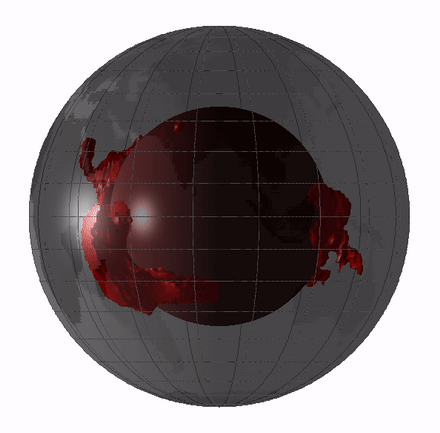Weird Wednesday: Large low-shear-velocity provinces

Scientists have discovered the remnants of a planet that crashed into the Earth billions of years ago leaving to large blobs of dense material on opposite sides of the Earth’s core.

It has been theorized that this collision also knocked out enough material to form the moon.
According to science (and Wikipedia):
The current leading hypothesis for the LLSVPs is the accumulation of subducted oceanic slabs. This corresponds to the locations of known slab graveyards surrounding the Pacific LLSVP. These graveyards are thought to be the reason for the high velocity zone anomalies surrounding the Pacific LLSVP and are thought to have formed by subduction zones that were around long before the dispersion—some 750 million years ago—of the supercontinent Rodinia. Aided by the phase transformation, the temperature would partially melt the slabs to form a dense melt that pools and forms the ultra-low velocity zone structures at the bottom of the core-mantle boundary closer to the LLSVP than the slab graveyards. The rest of the material is then carried upwards via chemical-induced buoyancy and contributes to the high levels of basalt found at the mid-ocean ridge. The resulting motion forms small clusters of small plumes right above the core-mantle boundary that combine to form larger plumes and then contribute to superplumes. The Pacific and African LLSVP, in this scenario, are originally created by a discharge of heat from the core (4000 K) to the much colder mantle (2000 K); the recycled lithosphere is fuel that helps drive the superplume convection. Since it would be difficult for the Earth’s core to maintain this high heat by itself, it gives support for the existence of radiogenic nuclides in the core, as well as the indication that if fertile subducted lithosphere stops subducting in locations preferable for superplume consumption, it will mark the demise of that superplume.
Naw…I didn’t read it either.
-Leon

Leon Stevens is a multi-genre author, composer, guitarist, songwriter, and an artist, with a Bachelor of Music and Education. He published his first book of poetry, Lines by Leon: Poems, Prose, and Pictures in January 2020, followed by a book of original classical guitar compositions, Journeys, and a short story collection of science fiction/post-apocalyptic tales called The Knot at the End of the Rope and Other Short Stories. His newest publications are the novella trilogy, The View from Here, which is a continuation of one of his short stories, a new collection of poetry titled, A Wonder of Words, and his latest sci-fi mystery, Euphrates Vanished.
My new book page: http://books.linesbyleon.com/

Free books? Sign up for my bi-weekly newsletter and choose one or more!
books.linesbyleon.com/Newslettersignup

Join my email list
RECEIVE A FREE EBOOK WHEN YOU SUBCRIBE TO MY WEEKLY NEWSLETTER
Processing… Success! You're on the list. Whoops! There was an error and we couldn't process your subscription. Please reload the page and try again.Leon Stevens is a multi-genre author, composer, guitarist, songwriter, and an artist, with a Bachelor of Music and Education. He published his first book of poetry, Lines by Leon: Poems, Prose, and Pictures in January 2020, followed by a book of original classical guitar compositions, Journeys, and a short story collection of science fiction/post-apocalyptic tales called The Knot at the End of the Rope and Other Short Stories. His newest publications are the novella trilogy, The View from Here, which is a continuation of one of his short stories, a new collection of poetry titled, A Wonder of Words, and his latest sci-fi mystery, Euphrates Vanished.
My new book page: http://books.linesbyleon.com/

Free books? Sign up for my bi-weekly newsletter and choose one or more!
books.linesbyleon.com/Newslettersignup




